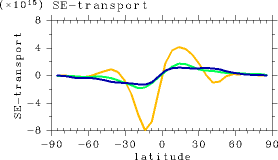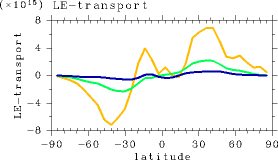E. Atmospheric Structure in Equilibrium States |
j. Meridional Energy Transport
Figures 1(a) and 1(b) illustrate dry static energy transport and latent heat transport, respectively, for Experiments S1380, S1570, and S1200 . With an increasing solar constant, energy transport increases. An increase in latent heat energy transport is evident especially in high latitudes. When solar constant increases, condensation heating at high latitudes and meridional latent heat energy transport increase, which is consistent with the decrease of meridional temperature differences. An examination of the partitioning of meridional energy transport shows that disturbances are mainly responsible for increased latent heat transport at high latitudes. This suggests that latent heat transport by disturbances contributes significantly to increased energy transport associated with an increased solar constant. For details on the partitioning of energy transport for each experiment, see Meridional Energy Transport in Experiment S1380, Meridional Energy Transport in Experiment S1570, and Meridional Energy Transport in Experiment S1200. |
(a)  (b)  Figure 1:Meridional energy transport (W). (a) Meridional dry static energy transport. (b) Meridional latent heat transport. Dark blue: results from Experiment S1200. Green: results from Experiment S1380. Orange: results from Experiment S1570. |
List of images referred to above: